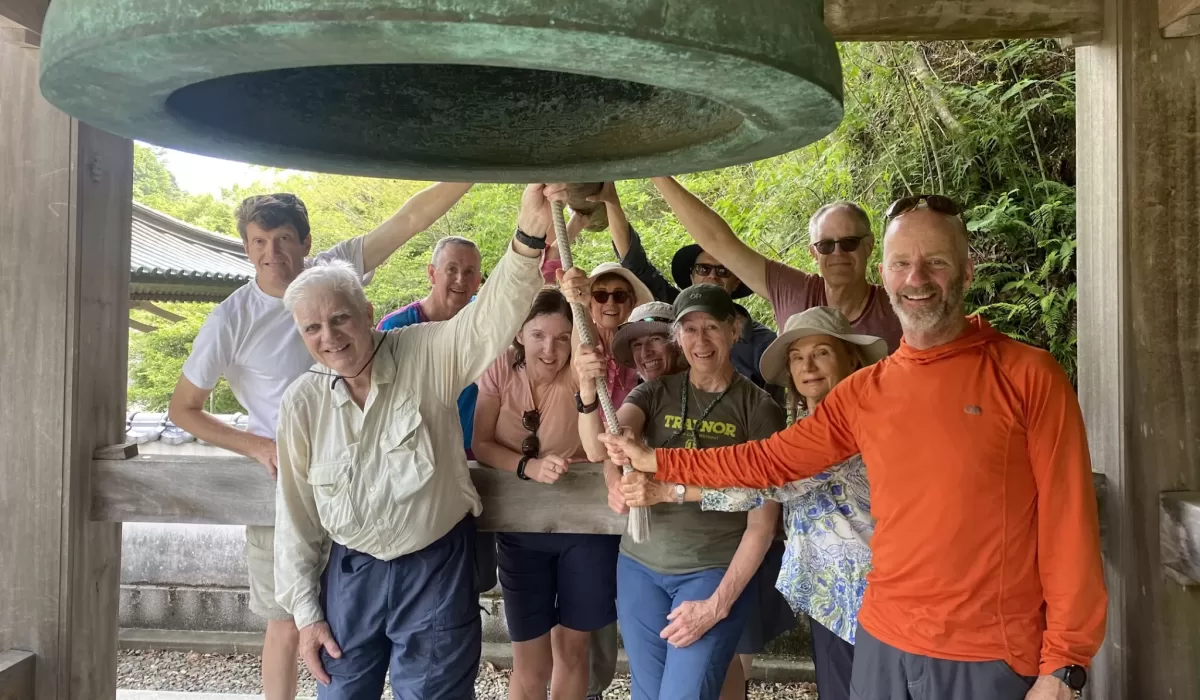by Guest Blogger, Kate Dernocoeur
Our group of twelve Westerners pauses at the temple gate where the imposing Nio statues stand guard. We are new to the proper etiquette, so Tom, our guide, teaches us to bow upon entering the temple grounds. One of us rings the giant bell to announce our collective arrival. Nearby, an iron dragon spouts water into a clean trough. I take a bamboo-handled cup, dip it, let the cool water wash across the free hand, careful to let the water run to the waiting moss and plants below instead of back into the washing water. I switch, and rinse the other hand, then take a ceremonial sip. Lastly, I tip the cup so the remaining water can rinse the handle. I am clean, and ready to go in.


Near the rows of lighted candles on a protected rack, Tom hands us each a short white candle and three sticks of incense. Pensively, we light our candles and place them on individual holders near others already burning inside the case. From the candle, I light the incense. These smoky sticks go in the sand heaped in a bronze vessel nearby. The smoke wafts up, carrying our prayers. Mine are always for my daughter, son-in-law, and granddaughter, the three of them.

Then we gather by the temple steps, out of the way of others. Together, we chant the Heart Sutra from pages Tom has given us. Paper handouts with the sutra spell it all out phonetically on a 12×23 grid: “Kan-Ji-Zai-Bo-Sa-Gyo-Jin…”. At first, the chant feels awkward—bordering perhaps on appropriation of someone else’s spiritual practice. But Tom says, no, it’s okay. By our final day, we will recite it with relative ease, maybe even with a bit of wistfulness to have reached the end. But we are far from the finish on that first day! In the 10 days ahead, we will walk long and hard, mostly along the outer edges of the Japanese island of Shikoku, the fourth-largest of the archipelago.


Shikoku 88 Temple Pilgrimage
Shikoku’s 88 Temple Pilgrimage came along about 1,200 years ago, making it one of the oldest pilgrimages in the world. We will walk 62 of its 750 miles, visiting 27 of its 88 temples. The pilgrimage was created to honor a man named Kukai (also called Kobo-Daishi) (774-835 CE). He was born on Shikoku, and is the deeply revered founder of the Shingon Buddhist sect. The pilgrimage path wends from one temple to the next in a circle around the island. Although each temple is dedicated to a different deity, there is also always a structure on the grounds in honor of Kukai, and a statue of him, too.
Pilgrims are known as “henro.” They are a common sight as they walk the roads in a conical reed hat and white clothing, carrying a stout wooden staff. Over the centuries, thousands have walked the entire route, sometimes multiple times—and still do. Others check off their lists one temple or two at a time. They may do it for piety, or perhaps ascetic reasons; others come to the pilgrimage with more of a tourist’s curiosity, but it doesn’t matter. Out there, we are all pilgrims—henro—on the path.

Nowadays, many people travel by car, bus, even taxi. Some ride their bicycles. We had the luxury of being guided by Tom and capably transported in a comfortable minibus driven by Okajima-san. a dear and ancient-looking Japanese man. On our route, we visited a well-curated list of especially enjoyable sections of it, staying overnight in pilgrim lodging at one temple and otherwise in traditional Japanese inns or, once, at a businessman’s hotel.


The walking was sometimes straightforward, but much of it was rigorous. With only about 11% of arable territory, Japan is impressively vertical, and the hillsides are dense with vegetation. As I ascended and descended many hillsides and stone stairs, I was often mindful that back in the 800s, when the pilgrimage started (and even, certainly, into the 20th century), pilgrims had no roads, tunnels, or bridges. If my feet got weary, I thought of the simple and fragile rice straw sandals worn by the original pilgrims. If I got hungry or thirsty, I thought of the eons of pilgrims relying for sustenance on the generosity and goodwill of humble farm families and temple priests. No mean feat even now, the 88 Temple Pilgrimage of yore would have been a much more daunting beast. As it was, for me it was a challenging, wonderful walk, boosted by a compatible and fun group and a very capable leader.

[For more information, go to the Walk Japan website for the opportunities they offer. Both trips I’ve taken with the company have been very special and well done. See: https://walkjapan.com]

Kate Dernocoeur received her MFA in Creative Non-Fiction writing from Western Michigan University and avidly finds excuses to use her craft to share her experiences and thoughts via her blog, “Generally Write.” She lives on a quiet property in rural western Michigan (when she isn’t somewhere else).










Comments
1 CommentSheryl Arredondo Jurries
Aug 26, 2024Excellent photos and good commentary. I was unaware of this journey. Very interesting.